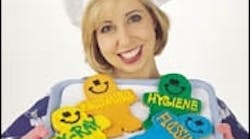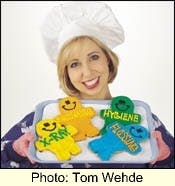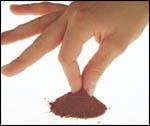Mix these ingredients for enriching encounters.
by Barbara Alexander, RDH
The first book introduced in many dental hygiene programs is Clinical Practice of the Dental Hygienist by Dr. Esther M. Wilkins. The book opens with a definition of dental hygienists, followed by a description of what hygienists do. Dr. Wilkins' definition of hygienists is:
"The registered dental hygienist is a licensed, professional oral health educator and clinical operator who, as an auxiliary to the dentist, uses preventative, therapeutic, and educational methods for the control of oral diseases to aid individuals and groups in attaining and maintaining optimum oral health."
Dr. Alfred Fones, the first dentist to use hygienists in a dental practice, described our work:
"It is primarily to this important work of public education that the dental hygienist is called. She must regard herself as the channel through which dentistry's knowledge of mouth hygiene is to be disseminated. The greatest service she can perform is the persistent education of the public in mouth hygiene..."
Right from the beginning, it was made clear that a primary responsibility of dental hygienists is, and always will be, patient education. In our professional lives, though, there is a limited amount of time — 45 to 60 minutes — in which to update medical histories, take X-rays, complete thorough exams, scale and polish teeth, and provide patient education. The preceding list doesn't include all of the discussions with patients about the new materials and procedures used in our dental offices today, so that they can take advantage of what we can provide. Some patients initiate the conversation by asking about things brought to their attention through the media, such as bleaching and composites.
To further challenge us, we apply our knowledge of the advances in dental research, which consistently prove the importance of oral health to our general health. This latest information has broadened our responsibility from oral health educators to general health educators.
Let's face it, the dental office is not a comfort zone for our patients. From their point of view, we invade their personal space, stick them, poke them, give them doses of radiation, deliver bad news, and then we reprimand them! It's no wonder we meet up with unwilling attitudes.
So how do we overcome all of this? Well, there is no formula for giving proper patient education because each hygienist has to develop a unique style, and each patient has individual needs to be addressed. A starting point, however, is our common goal of optimizing oral health through care and education. To achieve this, we not only have to have knowledge to share, but we also need to know how to communicate what we know and then motivate our patients to put this information to use. The purpose of this article is not to discuss what to say, but to offer the ingredients that can help make us better communicators and motivators.
A pinch of patient historyThe first step in preparing for our patients' visit is to review the chart. The chart contains information on recent treatment, treatments pending, and concerns or problems requiring follow up. So before even seeing the patient, we prepare for the patient education discussion.
Other information in the chart, such as broken appointments, can present opportunities for patient education. Sometimes broken appointments are unavoidable. With so many of us in the "sandwich generation" — where we are taking care of our children and elderly parents, and have jobs in which we travel — failure to make appointments is an unfortunate reality. Tread lightly when you do see your patient who has missed appointments; try not to appear judgmental. Your position should be one of concern. That concern will be noted if it is genuine, and it will foster open communication because your patient will feel safe with you. Finding out the reason for the broken appointment may open a door to a conversation about oral hygiene for children, the elderly, or busy individuals like themselves.
Broken appointments can also be due to fear of the dental office. This represents an opportunity to turn fearful patients into office regulars, depending on how we handle ourselves at this appointment. In these situations, perceptiveness, patience, and compassion may be all the education needed for this appointment. Sometimes, withholding patient education is appropriate and necessary, since it may help to create a safe, receptive environment that will keep patients coming back.
If patients keep returning, oral health obviously will improve, but future opportunities for patient education will arise. A "regular" patient forms a bond with the hygienist, developing trust in what the hygienist says. This may make, for example, a patient who has never flossed suddenly become a flosser regardless of how many times instruction to floss has been given.
In other words, what is in a patient's chart should be taken with a grain of salt and used in a positive way for patient education.
A teaspoon of first impressionsGiven that we are human, most of us have already formed an opinion of a patient by reading his history in the chart and by listening to comments made by other staff members. For example, the other hygienist might notice a patient's name in the schedule and wish you good luck, since the patient has broken several appointments and has poor oral hygiene.
This scenario may have you entering the appointment with less than an open mind and good spirit. There are two possible roads to take here. The low road is to clean the patient's teeth and get him out, therefore failing to educate this patient. Or the high road is to treat him as if you haven't already predetermined a first impression. If you take the high road, you may be the one hygienist he will listen to and keep coming back to see. For some reason, your personalities may be a good match, or maybe you are the first hygienist to give him a chance to make a first impression outside of what is written in the chart. Do not let what you read in the chart get in the way of building a good patient/hygienist relationship in which you can successfully deliver the appropriate patient education.
It is equally as important for our patients to get a good first impression of us. Consultants suggest referring to our patients as guests. Calling them guests may or may not be comfortable, but all patients should be treated as guests. In fact, to take it one step further, we should treat our patients as we do our family and friends. After all, this group of people makes up our most successful relationships. We communicate well with our guests primarily because there is comfortable conversation.
Comfortable conversations are accomplished by showing real interest in what is said, following up on what was learned during the last conversation, and sharing things about our own lives. Taking this method of conversation and using it in the dental office will help develop good relationships with patients (and with co-workers too). If patients and hygienists get to know each other, hygienists become people like them, as opposed to strangers and adversaries. As a result, there is shared comfort, respect, and trust. If patients trust you, they will listen to you.
Listening as much as talking is a key to good communication. Listening has to be done properly with focused attention. An example of proper body language and focused attention is making eye contact. This, of course, means no writing in the chart while your patient talks. Do not show you can "relate" to patients by interrupting their thoughts or finishing their sentences. Make sure that, if you can relate to what they are saying, you do not shift the focus from them and what they want to know. If we take an interest in our patients, ask questions, and listen intently, they will respond. Relieve their concerns, answer their questions, and offer them good advice.
Building good relationships is fundamental to being an effective patient educator, and it all starts with first impressions.
A tablespoon of approachThe approach to patient education changes with experience. Most of us start out overanxious to make a difference, and our approach is much like "a bull in a china shop." We soon learn that this aggressive method is counterproductive. With experience comes the ability to read people and know when the time is right to deliver patient education. When patient education is given at the right time with the right approach, our patients are more cooperative.
Timing is everything. Keep in mind that there is a whole appointment worth of time in which to educate our patients. You can start the appointment with patient education if it can be incorporated into the conversation at the beginning of the appointment. Things can be discussed, for example, during periodontal probing — a good time to explain periodontal disease, what the probing is for, or what has been found. The point is that patient education should not be limited to the end of the appointment, which may end in a rush for you or if the patient is anxious to leave.
Make sure the delivery of information is different for each patient. If patient education is personalized — as opposed to a "scripted speech" — it will add validity to what is said. Use your insight into different types of patients to help you personalize and successfully present information.
The "clean me and get me out" patient — These patients do not like too much chatter and really do not like patient education. Be clever here and introduce an idea into any part of a conversation. Like a subliminal message, slip the information to your patient while working or give a quick comment while waiting for the doctor's exam. These patients may be willing to listen next time if you show them you understand they are pressed for time at this appointment. Just plant a seed and get them out quickly as they asked.
The defensive or argumentative patient — We all have had those patients who often come in with an offensive comment right off the bat. Remember that these patients may be nervous, just testing the waters to see how much we care or how much we know. We need to keep our composure and give them what they need. If we can win them over, it is quite a coup.
The "let the doctor tell me" patient — Do not be offended. What a patient says does not change the fact that we know our stuff. It is our ethical, professional, and legal responsibility to give patients useful and thoughtful information. When opportunity strikes with these patients, just introduce an idea by saying that the doctor may discuss further treatment, as if to give them a heads up on inside information. Then let the doctor tell them. In the end, patients will respect you more when the doctor confirms what you have already said.
The "tell me everything" patient — There should be one of these in every schedule. Be careful; don't risk drowning patients in your enthusiasm to educate an open mind by giving an overwhelming amount of information. Be specific with what relates to that particular patient. When a patient has never flossed and asks for instructions, do not also introduce a Proxabrush and a rubber tip. Let the patient's enthusiasm for flossing be enough for now. If you move patients along slowly, they will more likely succeed and so will you.
Patients are more motivated to make changes if they are involved and feel in control. So many tools help us motivate and involve our patients. Digital X-rays and intraoral cameras are two such tools that allow patients to see what we see in their mouths. As far as motivating goes, a picture is worth a thousand words.
A secret ingredientThrow in a measure of good humor just to add a little flavor.Bake all ingredients for an entire careerWe have an opportunity to touch many lives. We are not only about cleaning teeth we are also sources of information about health in general. Sometimes we are the only ones to listen with concern to people who need someone to care. At the end of our careers — through patient education and caring for others — we will have affected many people. There is a saying if you have made one true friend you can consider yourself rich. Well in that same line, if you have made a difference in one patient's life you can savor the taste of a successful career.APPOINTMENT CHECKLISTUpdate Medical History- Update the list of medications that the patient is currently taking.
- Check to see if medical condition is under control. If not under control, advise patient to see his/her physician.
- Advise patients of any oral side effects that the medications or medical conditions may cause.
- If a patient reports there is a problem, assure him that not only will you be checking the problem, but that the doctor will be examining him too — the team is there for him.
- Take all information needed for diagnosis, such as history of the problem, visual findings of the site, probings, and X-rays. Explain the importance of each diagnostic tool used.
- Casual conversation between patient and hygienist may give information worth passing on to the doctor to consider in his/her treatment plan.
- Conversation gives insight into which solution or trick-of-the-trade to suggest. For example, if the patient mentions that he/she gets up at 4:00 a.m. for work now, suggest that flossing can be done at anytime of the day, such as at lunch when there may be more time and before the patient gets too tired.
- Patient education should be based on oral findings. For example, pockets in the interproximal areas would lead to flossing instruction. If there is an accumulation of plaque in the brushing areas, suggest an automatic toothbrush. If brushing and flossing areas look good but the periodontal condition does not, protocol dictates suggesting rinses, deep scalings, and/or referral to a periodontist, depending on office philosophy.
Barbara Alexander, RDH, practices in Buffalo Grove, Ill. She is also the owner of Day and Night Desktop Writers, a graphic design company that writes and designs brochures, business stationery, dental newsletters, and office manuals. She may be contacted by e-mail at [email protected].










